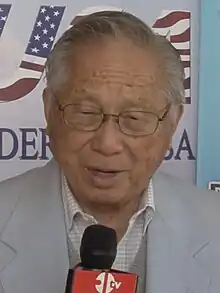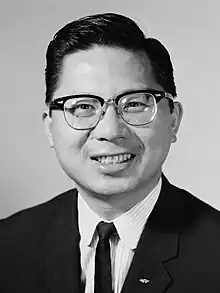Tom Hom | |
|---|---|
 Hom in 2019 | |
| Member of the California State Assembly from the 79th district | |
| In office January 6, 1969 – January 4, 1971 | |
| Preceded by | Frederick James Bear |
| Succeeded by | Peter R. Chacon |
| Personal details | |
| Born | Hom Cheuck Ngee February 15, 1927 San Diego, California, U.S. |
| Political party | Republican |
| Spouse(s) | Dorothy Hom (d. 1999) Loretta |
| Children | 6 |
| Residence | Chula Vista |
| Alma mater | University of California, San Diego |
| Occupation | Real estate developer |
Thomas E. Hom (born February 15, 1927) is an American politician in the state of California.[1] In 1963 he became the first non-caucasian elected to the San Diego City Council.[2] He served in the California State Assembly from 1968 to 1970.[1][3] Hom represented the 79th Assembly District;[4] he was the second Asian American elected to the California State Legislature.[5]
Background and early life
Hom's father came to the United States when he was only 15 years old with little cash aboard the Manchuria in 1909, changing his name to David due to influence from Presbyterian missionaries in China. In all he fathered 12 children. Hom's father named him after Thomas Edison;[6] he also named his other children after notable Americans, such as Francis Scott Key and Paul Revere. Hom's mother died when Tom was four years old and his father died when Tom was 12.[5] Prior to entering kindergarten, Hom was unable to speak English.[7]
Beginning at the age of 15, he began to work at the family business, David Produce Company, and then graduated from San Diego High School.[8] During World War II, Hom worked on a farm which his family had taken over from a Japanese American family; the farm was located on the present site of SDCCU Stadium.[9] In 1947, he moved to North Park with his stepmother, overcoming racial covenants which would have barred them. Before becoming a politician Hom held multiple jobs, including work in food service, agriculture, and broadcasting.[5] Taking classes at night, Hom went on to earn a degree in business administration from the University of California, San Diego.[8]
Political career

At the age of 36, Hom was elected to the San Diego City Council; by 1962, he was the deputy mayor of San Diego.[10] When Hom was re-elected in 1967, he won with 87% of the vote, as of 2010 this has been largest plurality of the vote in any election in San Diego.[11] While a politician, Hom was involved in getting San Diego Stadium built, and the gentrification of the Gaslamp Quarter.[5] In 1968, with the encouragement of Ronald Reagan, Hom ran for a seat in the California State Assembly, and won.[8] Until Chris Cate was elected in 2014, Hom had been the only Asian American to have been elected to the San Diego City Council.[12]
Post-political career
Founding a real estate company, named after himself, Hom played a major role in developing Downtown San Diego;[8] this began in 1973, when Hom and his brother purchased the building that had housed the Security Pacific National Bank, which was first built in 1884.[13] Hom was the first president of the Gaslamp Quarter Association in 1982.[7][14] Remaining involved in public policy Hom made an effort to save buildings important to the history of Chinese Americans in San Diego, criticizing reports on historical significance that lacked input from the Chinese American community.[15] In the late 1990s his company went on to expand into projects in the Las Vegas area;[16] this included low cost housing, with the construction of Campaige Place in 2000.[17]
Personal life
His family owned the Western Metal Supply Company, which was integrated into Petco Park when it was constructed. He was married to his wife Dorothy for 48 years until her death from cancer in 1999. In 2013, she was posthumously entered into the Hall of Fame of the Women's Museum of California.[18] He married again, to Loretta, with whom he practices Tai Chi.[5]
In 2014, Hom's autobiography was published;[19] That same year the Rotary Club of San Diego presented to Hom the "Mr. San Diego" award, and San Diego Mayor Kevin Faulconer declared the day when he received the award to be Tom Hom Day.[20] As of July 2015, Hom resides in Southeast Chula Vista.[21] In 2017, his art work was displayed at the San Diego Chinese Historical Museum.[6][22]
Bibliography
- Tom Hom (2014). Rabbit on a Bumpy Road: A Story of Courage and Endurance. Sunbelt Publications, Incorporated. ISBN 978-0-932653-44-4.
References
- 1 2 Andrew Aoki; Okiyoshi Takeda (2008). Asian American Politics. Polity. p. 104. ISBN 978-0-7456-3446-3.
- ↑ "Renowned Visionary Tom Hom Honored At The Gaslamp Quarter's 150th Anniversary Gala!". gaslamp.org. Gaslamp Quarter Association. November 2017. Archived from the original on 2017-11-17. Retrieved 16 May 2018.
Chinese America, History and Perspectives. Chinese Historical Society of America. 1998. p. 70. ISBN 9781885864055. - ↑ "Tom Hom". Chinese American Exclusion/Inclusion. New-York Historical Society Museum & Library. 2014. Retrieved 16 May 2018./
- ↑ "A History of Asian Americans in the California Legislature". Asian Pacific Islanders Legislative Caucus. California State Legislature. Retrieved 16 May 2018.
- 1 2 3 4 5 Wilkens, John (25 May 2014). "Political pioneer Hom writes memoir". San Diego Union-Tribune. Retrieved 19 May 2018.
- 1 2 Cabrera, Marissa; Cavanaugh, Maureen (23 May 2017). "Exhibit Reveals The Art Of Former San Diego City Councilman Tom Hom". KPBS. San Diego. Retrieved 19 May 2018.
- 1 2 Bell, Diane (25 August 2014). "Tom Hom to be 'Mr. San Diego'". San Diego Union-Tribune. Retrieved 19 May 2018.
- 1 2 3 4 Kelly, Jim (14 August 2014). "Tom Hom, San Diego Legend, Addresses Roundtable". Coronado Eagle & Journal. Retrieved 19 May 2018.
- ↑ Reza, H.G. (2 December 1991). "Dec. 7, 1941 : The Japanese bombing of Pearl Harbor changed forever America's place in the world, shattering reality and perceptions. After that Sunday morning 50 years ago, nothing was quite the same. It was a benchmark for a generation of Americans--the when, where and how of that day are as clear as if it were yesterday. For people in San Diego in 1941 and for those who arrived here later, the war left an indelible mark. Here, in their words, from interviews with Times staff writers H.G. Reza and Nancy Ray, are a few of their stories". Los Angeles Times. Retrieved 19 May 2018.
- ↑ "Thomas Hom". KPBS. 24 May 2011. Retrieved 19 May 2018.
- ↑ "Asian Heritage Society to Honor Tom Hom". San Diego Metro Magazine. 1 February 2010. Retrieved 19 May 2018.
- ↑ "Ballots Cast, Preliminary Results Reported in Local Races". KNSD. San Diego. 5 November 2014. Retrieved 19 May 2018.
"Welcome Celebration for Councilman Elect Chris Cate". sdaafe.org. San Diego Asian Americans for Equality. 22 November 2014. Retrieved 19 May 2018. - ↑ San Diego's Gaslamp Quarter. Arcadia Publishing. 2003. pp. 112–113. ISBN 978-0-7385-2865-6.
- ↑ "Gaslamp Quarter History - Downtown San Diego Origin and Historical Events". Gaslamp Quarter | Downtown San Diego. Retrieved 2023-09-02.
- ↑ Leland T. Saito (2009). The Politics of Exclusion: The Failure of Race-neutral Policies in Urban America. Stanford University Press. pp. 50–60. ISBN 978-0-8047-5929-8.
Saito, Leland (Winter 2003). Hennessey, Gregg (ed.). "Reclamation and Preservation". The Journal of San Diego History. 49 (1). Retrieved 19 May 2018. - ↑ Radke, Jace (28 July 1998). "New type of low-cost apartment on the way". Las Vegas Sun. Retrieved 19 May 2018.
- ↑ LeRoy, Gerg (Summer 2010). "Making the Connection: Transit-Oriented Development and Jobs" (PDF). Community Investments (2): 13–17, 45. Archived from the original (PDF) on 2016-05-18 – via Federal Reserve Bank of San Francisco.
- ↑ "Dorothy Hom". Women's Museum CA. Women’s Museum of California. 2013. Retrieved 19 May 2018.
- ↑ Cavanaugh, Maureen; Burke, Megan; Pico, Peggy (21 May 2014). "San Diego Political Legend Tom Hom Talks About 'Bumpy Road' To American Dream". KPBS. San Diego. Retrieved 19 May 2018.
"San Diego Political Legend Tom Hom Coming to Warwick's Wednesday, Sept 10". La Jolla Blue Book. 9 September 2014. - ↑ "Mr. San Diego 2014" (PDF). The Rotator. San Diego: San Diego Rotary Club. 25 September 2014. Retrieved 19 May 2018.
- ↑ Zaragoza, Barbara (17 July 2015). "Filipino-American Community Wins Big In Chula Vista Districting". San Diego Free Press. Retrieved 10 May 2018.
- ↑ "Unseen Portrait: The Art of Tom Hom". San Diego Reader. 20 May 2017. Retrieved 19 May 2018.
External links
Hom's media
Government
- "Hon. Councilmember Tom Hom" (PDF). City of San Diego. 1967.
- 2014 Congressional Record, Vol. 160, Page E14028 (August 1, 2014)
- Roberts, Ron (19 February 2017). "Honoring Tom Hom". County of San Diego.
Other
- Vassar, Alex; Meyers, Shane (2005). "Tom E. Hom". Join California.